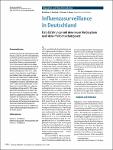Influenzasurveillance in Deutschland
Erste Erfahrungen mit dem neuen Meldesystem nach dem Infektionsschutzgesetz
Brodhun, Bonita
Buchholz, Udo
Kramer, Michael H.
Breuer, T.
Das Sentinelsystem der Arbeitsgemeinschaft Influenza (AGI) hat seit 1992 wertvolle Daten zur Influenzaaktivität in der gesamten Bundesrepublik Deutschland gesammelt. Die dabei erfassten Daten zu akuten respiratorischen Erkrankungen bilden die Grundlage für die Bewertung der aktuellen Verbreitung der Influenza. Mit dem Inkrafttreten des Infektionsschutzgesetzes (IfSG) am 1.1.2001 wurde in Deutschland ein neues Meldesystem etabliert. Dabei ist erstmals auch der Nachweis von Influenzaviren meldepflichtig, und zwar über den Meldeweg nach §7.1 IfSG (vorgegebene maximale Übermittlungszeit von 17 Tagen vom Gesundheitsamt bis zum Robert Koch-Institut (RKI)) sowie über eine Schnellübermittlung nach §12 IfSG (vorgegebene Übermittlungszeit von einem Tag). Wir analysierten die Elemente und Inhalte dieses neu angelaufenen Meldesystems und verglichen die Ergebnisse mit denen des AGI-Sentinels. Die Meldedaten nach §12 und die Daten des AGI-Sentinels beschrieben den Verlauf der Influenzawelle übereinstimmend. Insgesamt hat das neue Meldewesen seine Funktionstüchtigkeit eindrucksvoll unter Beweis gestellt. Until recently, influenza surveillance in Germany was conducted through a physician-based sentinel system, the “Arbeitsgemeinschaft Influenza” (AGI), where acute respiratory illnesses are recorded. With the institution of the Protection against Infection Act (IfSG) in January 2001, the laboratory diagnosis of influenza has become notifiable via two different reporting lines: according to § 7.1 IfSG, reporting from the local health department to the Robert Koch-Institute must occur within a maximum of 17 days while rapid reporting according to § 12 IfSG must occur within one day. We analyzed data of the new surveillance system and compared the results with those of the AGI. The epidemic influenza curve according to § 12 was comparable with that of the AGI sentinel system. Overall, the new reporting system has proven its functional capability.
Files in this item
No license information

